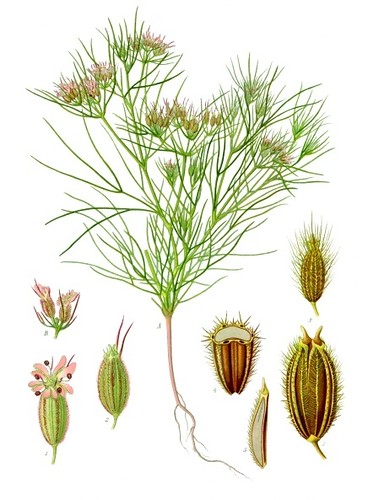
(Public Domain image)
Cumin at Wikipedia
Favorite Facts from the Wiki article:
The spice is native to Arabic-speaking Syria where cumin thrives in its hot and arid lands. Cumin seeds have been found in some ancient Syrian archeological sites.
Cumin is the dried seed of the herb Cuminum cyminum, a member of the parsley family. The cumin plant grows to 30-50 cm (1-2 ft) tall and is harvested by hand.
Seeds, excavated at the Syrian site Tell ed-Der, have been dated to the second millennium BC. They have also been reported from several New Kingdom levels of ancient Egyptian archaeological sites.[4]
The Greeks kept cumin at the dining table in its own container (much as pepper is frequently kept today), and this practice continues in Morocco. Cumin fell out of favour in Europe except in Spain and Malta during the Middle Ages. It was introduced to the Americas by Spanish colonists.
Superstition during the Middle Ages cited that cumin kept chickens and lovers from wandering. It was also believed that a happy life awaited the bride and groom who carried cumin seed throughout the wedding ceremony. Cumin is also said to help in treatment of the common cold, when added to hot milk and consumed.
Cumin seeds are used as a spice for their distinctive aroma, popular in North African, Middle Eastern, Western Chinese, Indian, Cuban and Northern Mexican cuisine. According to http://www.foodreference.com/html/fcumin.html cumin is the second most popular spice in the world after black pepper.
The spice is a familiar taste in Tex-Mex dishes and is extensively used in the cuisines of the Indian subcontinent
Cumin seeds are a good source of iron.
Cumin seeds have traditionally been noted to be of benefit to the digestive system, and scientific research is beginning to bear out cumin's age-old reputation. Research has shown that cumin may stimulate the secretion of pancreatic enzymes, compounds necessary for proper digestion and nutrient assimilation.
Favorite Facts from the Wiki article:
The spice is native to Arabic-speaking Syria where cumin thrives in its hot and arid lands. Cumin seeds have been found in some ancient Syrian archeological sites.
Cumin is the dried seed of the herb Cuminum cyminum, a member of the parsley family. The cumin plant grows to 30-50 cm (1-2 ft) tall and is harvested by hand.
Seeds, excavated at the Syrian site Tell ed-Der, have been dated to the second millennium BC. They have also been reported from several New Kingdom levels of ancient Egyptian archaeological sites.[4]
The Greeks kept cumin at the dining table in its own container (much as pepper is frequently kept today), and this practice continues in Morocco. Cumin fell out of favour in Europe except in Spain and Malta during the Middle Ages. It was introduced to the Americas by Spanish colonists.
Superstition during the Middle Ages cited that cumin kept chickens and lovers from wandering. It was also believed that a happy life awaited the bride and groom who carried cumin seed throughout the wedding ceremony. Cumin is also said to help in treatment of the common cold, when added to hot milk and consumed.
Cumin seeds are used as a spice for their distinctive aroma, popular in North African, Middle Eastern, Western Chinese, Indian, Cuban and Northern Mexican cuisine. According to http://www.foodreference.com/html/fcumin.html cumin is the second most popular spice in the world after black pepper.
The spice is a familiar taste in Tex-Mex dishes and is extensively used in the cuisines of the Indian subcontinent
Cumin seeds are a good source of iron.
Cumin seeds have traditionally been noted to be of benefit to the digestive system, and scientific research is beginning to bear out cumin's age-old reputation. Research has shown that cumin may stimulate the secretion of pancreatic enzymes, compounds necessary for proper digestion and nutrient assimilation.
* * *
In my mind, next to chili powder, cumin is the most important spice in chili. I can't imagine chili without cumin! I also use it a lot during the summertime in curry dishes. I always have the whole seed on hand. Not only is it cheaper to buy it in bulk (true with pretty much all spices), but the flavor is more intense. Cumin is one of the spices that I dry toast before using.
To dry toast:
In a cast iron frying pan, without oil, constantly stirring, toast the seeds until they start to brown slightly. The most important indicator that the seeds are ready, however, is that they become intensely fragrant.
My spice boxes, cumin seeds
* * *
My husband has officially adopted chili as his dish! Last time we made it he assisted. This time he offered to make it during what was a very long work week for me, and has become obsessed with experimenting with ingredients. What follows is the result of this weeks experiment--a mild chili with a hint of fragrant mole. He's talking about making carnitas next--I think his Texan heritage is starting to kick in!
Ingredients:
- Vegetable oil
- 2 LB pork, cubed
- 1 onion chopped
- 1 stalk celery chopped
- 1 tsp cumin seeds
- 1 tsp oregano
- 1/2 tsp cinnamon
- 1/2 tsp cocoa powder
- 2 TB chili powder
- 2 cups tomato sauce
- small can jalapenos (can't remember what ouce, just the itsy bitsy can)
- Bottle of Beer
- 1/2 cup coffee
- 32 oz of canned beans
- 1 TB honey
- Brown the pork in vegetable oil in a large pot--Richard used my 6 quart enamel cast iron pot.
- Add the onion and celery and saute for several minutes.
- Meanwhile, dry fry the cumin until aromatic, grind in a spice grinder or mortar and pestle.
- Add spices, tomato sauce, chilis, coffee,and beer to the meat and vegetables.
- Bring to a boil.
- Cover and cook for an hour.
- Add canned beans and sugar.
- Cook for 10 minutes.


sounds good - I thought you used diced tomatoes in your chili for some reason.
ReplyDeletemom
http://karensquilting.com/blog/
I have sometimes in the past. I think Ric said he might add some next time. :)
ReplyDeleteHi, I just found your blog a couple of weeks ago. I appreciate the post on cumin. Have you tried picadillo? Most recipes call for ground beef, but I suppose you could use diced beef.
ReplyDeleteI use cumin, garlic, onion, green pepper, and diced tomatoes in it. I serve it over rice, brown, of course. Very delicious!
Joyce Barham
Omaha, AR
Joyce, I had never heard of picadillo before, but have promptly looked up a couple of recipes and added it to my short list of future experiments! Thanks for bringing it to my attention (anything with cumin is certainly worth a try), and thanks for reading!
ReplyDeleteAlso, I just looked up Omaha on the map and you've brought back lovely recollections of drives between Dover and Harrison and all along the Buffalo River area--I've never made it as far north as Omaha, however.